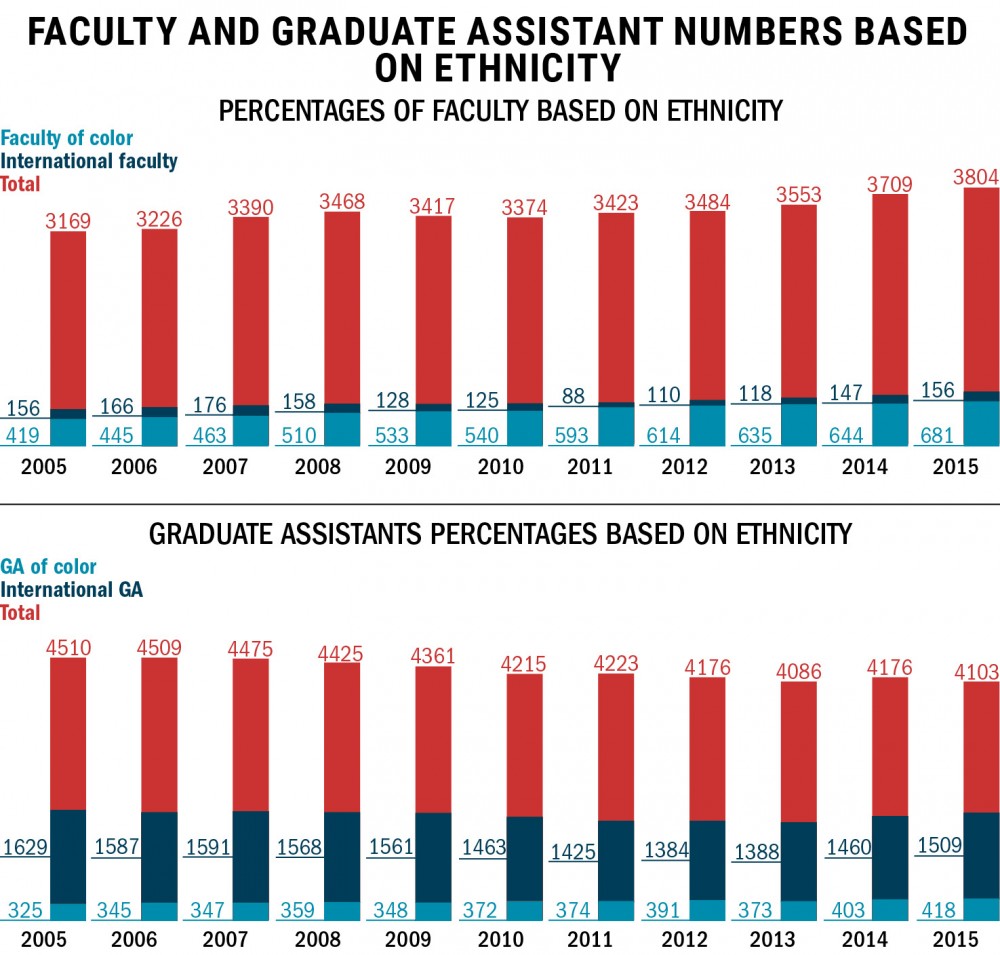In reaction to a year of protests, the University of Minnesota began to hire more faculty of color last year, but some say it’s not enough.
The University hired four faculty members in ethnic studies departments after the Race, Indigeneity, Gender and Sexuality Studies Initiative started, but faculty of color remain underrepresented in most departments. Some University professors of color raised concerns about retention and recruitment efforts of faculty of color, adding to the growing national discourse.
Over nearly four decades, the political science department has offered professorship to seven faculty of color and hired only one, said Political science professor August Nimtz Jr.
He said the department looked at national data for doctoral and graduate candidates who were qualified for the positions and found only seven people of color during those forty years who fit the requirements.
Rose Brewer, an African-American studies professor, said the road to professorship starts in graduate school, where access for students of color is limited.
Schools often look for quality candidates when hiring, said Marybeth Gasman, a professor at the University of Pennsylvania, and writer of a recent opinion piece on the lack of diverse faculty for the Hechinger Report.
Quality usually means the candidates must have a Ph.D from an elite school, Gasman said, and because of societal barriers, few people of color make it that far.
“Often times, people of color are discouraged from earning Ph.Ds or have negative experiences resulting in their leaving the professoriate,” she said.
Brewer said there is a “pipeline” to graduate school that often excludes students of color.
Gender and sexuality studies professor Jigna Desai said institutions sometimes let racial biases into their recruitment efforts by identifying a group of people in certain expertise.
To fight recruitment bias, the University introduced a new implicit bias initiative this school year, said Provost Karen Hanson.
Hanson said the initiative trains faculty recruitment committees to avoid biases when looking at candidates. The University has a large stake in increasing diversity, she said.
Retaining faculty of color
Retaining faculty of color is similar to retaining other faculty — in terms of salaries or resources — and other aspects like social connections and representing their ethnicity, Hanson said.
To keep faculty members of color at any university, the entire system needs change, starting with students still in college, said Rebecca Ropers-Huilman, a professor in the College of Education and Human Development.
“[Colleges should] make [students] think that academia is for them … strengthen their ability and like the institution,” she said.
Hanson said one significant factor in retaining faculty is to make sure they have connections to their heritage and culture outside the college.
“[Otherwise] the lone person of color feels like an outsider,” Desai said.
Instead of making faculty members of color assimilate to the institution once accepted, the college “needs to make the institution available for them,” Ropers-Huilman said.
Desai said that mentoring and advising could improve retention rates because faculty and students of color would have a better sense of community and get a better support system on campus.
Additionally, Desai said, the school needs to retain senior faculty so they can help younger faculty members deal with any issue that come up in their first years on campus.
Historically, a lack of diversity
Brewer said issues of race and racism have always existed in institutions of higher education because they have not prioritized diversity, she said.
In 1993, the Minnesota Daily reported on the lack of diversity at the school despite numerous initiatives to increase faculty of color.
Between 1988 and 1991, the number of faculty of color increased from 6.6 to 8.5 percent.
Now, that number is almost 18 percent.
The University has made good progress since that time, Ropers-Huilman said.
The University recently became a member of the National Center for Faculty Development and Diversity, she said. The center provides mentorship and advising that is accessible to both graduate students and faculty members of color.
Still, some faculty of color say the University should do more.
The University’s effort around recruiting faculty of color is mostly talk, Desai said.
“I feel like there’s a lot of hand-wringing, [people] saying ‘we don’t know what to do,’” she said.
Proven methods — like mentoring and outreach — can help retain more people, she said.
Some still say the reason colleges don’t hire more faculty of color is because they don’t want them, like Gasman said in her controversial opinion piece.
“What I meant is that if you really want to hire a diverse faculty, you don’t make excuses and put up road blocks. I see many people [doing that],” she said.
If the only improvements the University can point to is the four new faculty of color in ethnic studies and implicit bias training for recruiters, there is more to be done, Desai said.
“Why isn’t diverse faculty a presumption to have rather than some sort of ideal to strive for?” Desai said.








